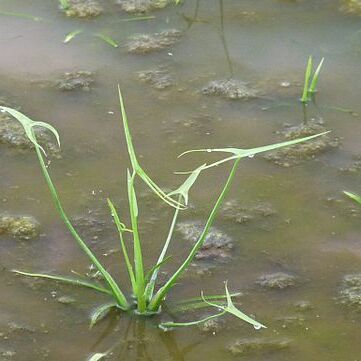Glabrous, laticiferous. Emerged leaves erect, sagittate, with linear to lanceolate lobes; terminal lobe acutely attenuate, 4-9.5 cm long measured along midrib, 1-3 cm wide; basal lobes with needle-like tips, 1-1.5(-2) times as long as the terminal one, as wide as it; nerves in the terminal lobes 5-7(-9), in the basal ones 4(-5), connected by ± parallel cross-veins under an angle of 45-70°, these connected again by veinlets parallel with the Main nerves; petiole sharply triangular, ribbed, with air-channels, 20-60 cm, septations c. 4-5 mm spaced in sicco distinctly prominent; sheath with broad scarious margin. Peduncles 1-5, erect, sharply triangular, often hexa-or polygonal, incl. the raceme 25-50(-90) cm. Raceme 1/3-1/2 as long as the peduncle, with 2-6 whorls of 3 flowers, 1-3 lower whorls female and mostly with 1-2 lateral branches, the other flowers male. Bracts only slightly connate at the base, broad-elliptic, acute, keeled, scarious-margined, 7 mm. Pedicels obliquely erect, ½-1½ cm, in female thicker than in male. Sepals broad-elliptic to suborbicular, blunt with scarious margins, 3-6 by 2.5-4 mm, after anthesis reflexed. Petals white, without a basal purple spot, suborbicular to broad-elliptic, much larger than the sepals (12-15 mm sec. BACKER), unguiculate. Stamens ∞, filaments glabrous, about as long as the anthers; anthers yellow, oblong, 1.5 by 0.75 mm. Carpels ∞, ovate, incl. the style c. 1 mm; style terminal, sometimes slightly curved; stigma punctiform. Fruiting heads globular, c. 1 cm. Achenes obovate, 3-5 by l.5-3 mm, with a broad dorsal and ventral wing, sides smooth; beak apical, straight, c. 0.5 mm. Seed light brown, 0.5 mm.
More
Plants stoloniferous, stolons often ending in a tuber. Leaves aerial at least when mature, sagittate, sheathing, apex acuminate to rounded, lateral lobes longer than middle lobe. Inflorescences racemose, in 3 to many whorls of 3 flowers, lower 1-3 whorls usually branched; bracts free or connate toward base. Flowers unisexual; female flowers on lower 1-8 whorls, with short pedicels; male flowers with pedicels 0.5-1.5 cm. Sepals reflexed, ovate, 3-5 × 2.5-3.5 mm. Petals obovate, ca. 2 × as large as sepals. Stamens numerous; anthers yellow. Achenes obliquely obovoid, 4.5-5.5 × 4-5 mm, winged, with an erect, apical beak. Fl. and fr. May-Nov. 2n = 22*.
A herb. It keeps growing from year to year. The roots are like a lily bulb. They are 2-3 cm wide and 5-7 cm long. The corms are pale brown and rounded. The leaves are 18-25 cm long and have a long leaf stalk 40-50 cm long. The flowers are in a long panicle. The flower are about 2 cm across. The male and female flowers are separate.
Uses. Besides the native plant, there occurs an imported form or strain of Sagittaria sagittifolia in Malaysia, which has everywhere been imported by the Chinese. This has been described as S. sinensis SIMS and is cultivated in China partly as fodder for pigs (the whole plant), partly for the starch-containing, edible tubers which are produced on the ends of stolons. This plant is much coarser generally than the wild arrow-head and BURKILL ( BURKILL Dict. 1935 1942 ), who calls it var. sinensis, says that the Chinese brought it to the north of Malaya, where its cultivation is steadily increasing southwards from Wellesley to Perak, Pahang, and Selangor, for the sake of the edible tubers, the plants being fed to pigs.Some authors assume this form to flower rarely. Taxonomically it is generally considered to belong to S. sagittifolia and has even not been distinguished as a distinct variety in recent monographs.The same form was apparently cultivated much earlier by the Chinese in Banka where KURZ ( KURZ Nat. Tijd. N.I. 27 1864 221 ) records it from Chinese settlements round Muntok. This was also mentioned by HEYNE ( HEYNE Nutt. Pl. 1927 139 ) and it was described and figured by OCHSE & BAKHUIZEN VAN DEN BRINK Ind. Groent. 1931 8 f. 6 , who say it is rarely cultivated by Chinese near Djakarta, producing tubers 3-6 by 2-3.5 cm on 15-35 cm long stolons.Chinese in the Philippines equally cultivate this edible form, according tp W. H. BROWN ( W. H. BROWN Useful Pl. Philip. 1 1950 87 ), for the tubers in Camarines and round Baguio (Luzon).HILLEBRAND ( HILLEBRAND Fl. Haw. 1888 457 ) recorded its introduction in Hawaii by Chinese, and A. C. SMITH ( A. C. SMITH Bull. Torr. Bot. CI. 70 1943 533 ) assumes it of recent introduction in Fiji; WILDER ( WILDER Bull. Bish. Mus. 86 1931 16 ) gives it as introduced in Raratonga. In Australia EWART ( EWART Fl. Vict. 1930 95 ) says it is naturalized locally in Victoria since 1910.FILET ( FILET Plant. Bot. Tuin Weltevr. 1855 10 ) mentions S. sagittifolia as a vegetable, but this use cannot have been general and on a large scale as it is exceedingly rare in Java; probably he was misled by the vernacular names bia-hia and etjeng, which apply equally to the very common Monochorias.STEINMANN interpreted ( Trop. Natuur 23 1934 219 ) some bas-reliefs on Borobudur stupa in Central Java as representing a broad-leaved form of S. trifolia. As has been mentioned it is at present very rare in Java and certainly introduced.BOGIN ( BOGIN Mem. N.Y. Bot. Gard. 9 1955 222 ) mentions that S. latifolia WILLD. ( WILLD. Sp. Pl. 4 1805 409 ) is cultivated as a vegetable in California by Chinese and Japanese and that this has apparently been imported by them in Hawaii, but recorded there under the name S. sagittifolia L.
More
The roots are boiled and eaten. They have a bland, sweet taste. They need to be deep fried or boiled to remove the bitterness. The young leaf stalks are also used. The young leaves are used as a potherb.


